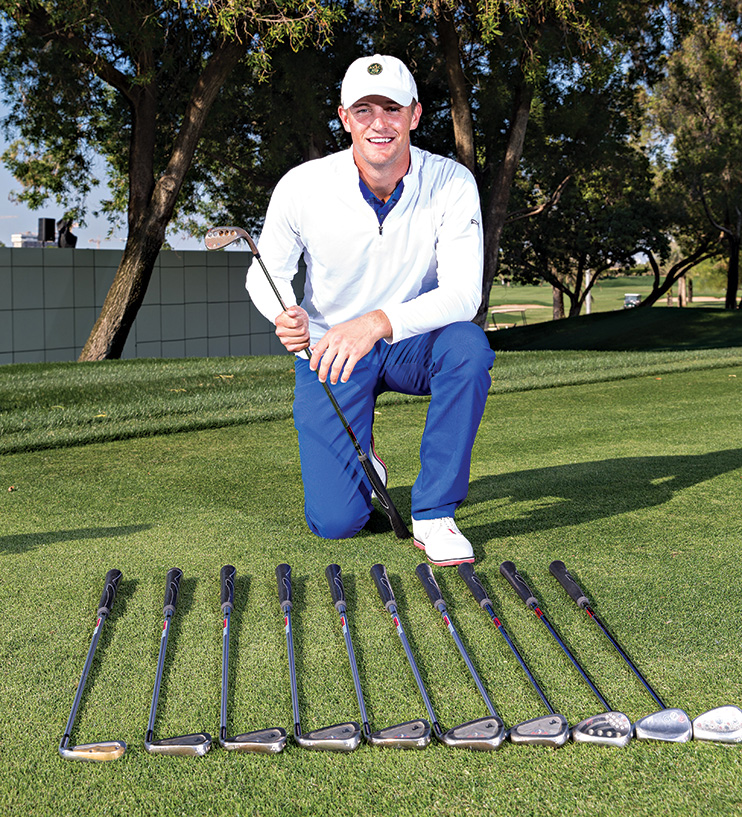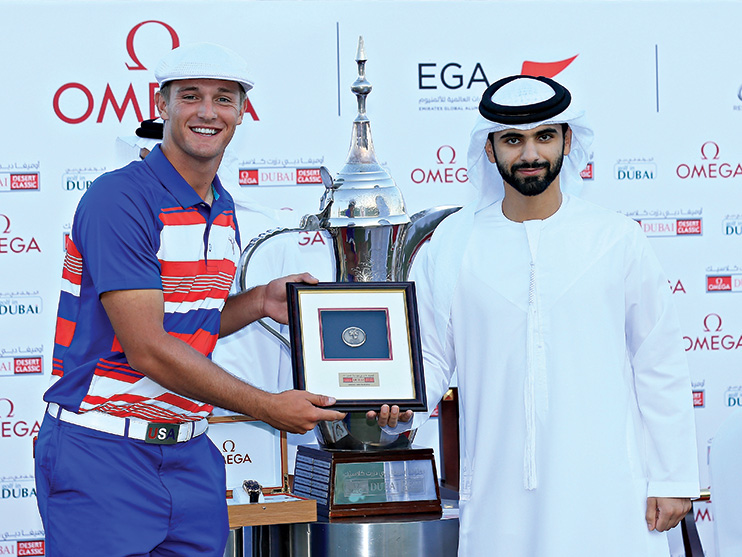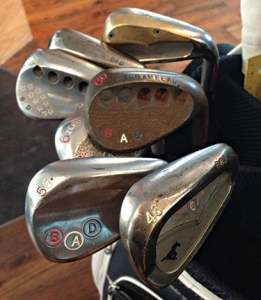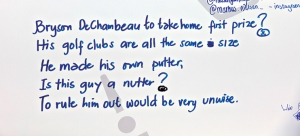By Robbie Greenfield
Portraits by Farooq Salik
U.S. Amateur champion Bryson DeChambeau is not just one of the brightest prospects in golf, but a man who has rejected its age-old conventions to devise a new (and potentially revolutionary) way of playing it. We caught up with this remarkable American amateur during last month’s Omega Dubai Desert Classic.
 ryson DeChambeau is a man of contrasts. Going by Hollywood movie stereotypes, he looks like the college jock and thinks like that character’s archenemy, the math nerd. He is both a scientist and an artist; an individualist with great style and an obsessive tinkerer who fixates on the smallest micro-detail that might yield a crucial edge. The man with his own ‘lab’ is no ordinary amateur golfer. He began his Middle East adventure on this year’s Desert Swing as a self-confessed intern, but by the time we met him for an exclusive interview on the Tuesday of the Omega Dubai Desert Classic, this remarkable 22-year-old from California had become one of the hottest topics in golf. Put simply, DeChambeau has the potential to be a game-changer. And his story is just beginning.
ryson DeChambeau is a man of contrasts. Going by Hollywood movie stereotypes, he looks like the college jock and thinks like that character’s archenemy, the math nerd. He is both a scientist and an artist; an individualist with great style and an obsessive tinkerer who fixates on the smallest micro-detail that might yield a crucial edge. The man with his own ‘lab’ is no ordinary amateur golfer. He began his Middle East adventure on this year’s Desert Swing as a self-confessed intern, but by the time we met him for an exclusive interview on the Tuesday of the Omega Dubai Desert Classic, this remarkable 22-year-old from California had become one of the hottest topics in golf. Put simply, DeChambeau has the potential to be a game-changer. And his story is just beginning.
[divider] [/divider]
Even without his trademark flat cap (which he reserves for tournament days only), Bryson DeChambeau carries an aura that belies his amateur status. We meet him at the entrance to the driving range at Emirates Golf Club, and everything we’ve heard about DeChambeau being a true gentleman is confirmed within the first 30 seconds.
Most top golfers are perfectly pleasant to deal with, but their interactions with the media tend to have a going-through-the-motions feel to them. Not Bryson. Unfailingly polite, alert and engaging, he comes across as a man who has never spent a day bored in his life.

Bryson DeChambeau displays his unique set of Edel Golf irons on the first tee of the Majlis course at Emirates Golf Club
Photo by Farooq Salik
Along with possessing a bottomless well of self-belief, DeChambeau is humble. He’s content to be the intern for now, despite the fact that he lit up the Abu Dhabi HSBC Golf Championship on day one with a sparkling round of 64, and shot a 65 at Yas Links to beat every single pro in the field in the Abu Dhabi Invitational. When asked to name the highlight of his trip, neither of those rounds gets the nod. “Playing golf with Rory [McIlroy] was incredible,” he replies, without hesitation.
DeChambeau was paired with the World No.3 in the third round at Abu Dhabi, shooting a 78 to McIlroy’s 70, and the fact that he would cite his worst score of the entire Desert Swing as the most valuable experience gives a good insight into his character.
“I learned a lot [from playing with Rory]. What impressed me about him was the fact he was able to stay calm and collected, no matter the situation, and that’s something I wasn’t able to do,” he admits. “I was definitely a little upbeat and my rhythm got out. It wasn’t so much a case of being nervous, it was a case of getting thrown out of my rhythm and not being comfortable in that situation. Although I didn’t play my best [on the weekend in Abu Dhabi] I learned a lot from the experience and that’s what being an intern is all about.”
Related: Bryson DeChambeau interview
Having either held or been one shot off the lead for the duration of the first two days, DeChambeau would eventually finish in a tie for 54th at Abu Dhabi Golf Club, before heading to Doha for the Qatar Masters and also make the cut there. His unbeaten 65 in the Abu Dhabi Invitational at Yas Links was followed by his best performance of the stretch at Emirates Golf Club, where he posted rounds of 70, 69, 68 and 69 to reach 12-under par and finish the Desert Classic in a tie for 18th place.

Finishing the Omega Dubai Desert Classic on 12-under, DeChambeau was awarded the low amateur prize
If the 22-year-old was looking for evidence that he is ready to make the transition into the professional ranks, he got more than enough over these three weeks. But before he relinquishes his amateur status, there is the small matter of Augusta National and the Masters, a tournament DeChambeau has been obsessing about since he became the fifth golfer in history to win the NCAA and U.S. Amateur Championships in the same season (he’s in decent company: the other four are Jack Nicklaus, Phil Mickelson, Tiger Woods and Ryan Moore).
At the mere mention of the Masters, DeChambeau’s face lights up. “I’m reading books on Augusta almost every day, getting to know Bobby Jones’ story and how he came to build Augusta National, and all the things that had to be right for that golf course to be made and for the Masters to happen. The history of that tournament is incredible, with all the great champions, and hopefully one day my name will be up there [with them] but that’s down the road. It’s something that I’m never going to worry about or think about until it happens, if it does. It’s all about the journey for me.”
This is DeChambeau’s philosophy in a nutshell. Like any dedicated scientist, he is all about the process, not the goal. No stone is left unturned in his quest to become the world’s best golfer, and it’s this approach, coupled with some astonishingly original thinking, that led DeChambeau to an equipment change that he believes could revolutionise the industry.
“Back in 2011, my coach Mike Schy gave me this book called The Golfing Machine and told me: ‘If you want to improve and learn the golf swing for yourself, then read this’,” DeChambeau recalls. He must have told this story many times already, but his eyes twinkle like a kid who has just made an amazing discovery and can’t wait to tell the first person they meet. DeChambeau had been deferential when talking about his experience of playing the European Tour. Now, he is animated. “Through this journey of learning different ins and outs of this book, I came across this motion called The Zero Shifting Motion, it’s in Chapter 10, Section 7a, and by zero shifting, what that means is you swing on a single plane,” he says.
Swinging on a single plane is easier said than done, but you won’t find a swing on tour that gets as close to it as DeChambeau’s. Even those who aren’t well versed in golf technique would quickly spot the quirks in his move. At set-up, his arms are extended so that they form a near straight line with the club shaft, as opposed to the conventional method of letting the arms hang down and the club protrude at anything between a 40 to 45 degree angle. It’s this starting point that allows him to make the one-plane swing because he returns the shaft to that exact position at impact.
“When I started to swing on one plane and tried it with different clubs in my bag, I soon realised that it wasn’t going to work because I was having to change my body posture based on those angles,” he says. “I kept thinking to myself, there has to be a way to do it, and eventually I came to the conclusion, why don’t we try making all my irons the same length?”
Like all the most profound ideas, it’s a concept that’s striking in its simplicity. You scratch your head and wonder, ‘how has no one thought of that before?’ But turning the idea into a reality was anything but straightforward.
“The first thing I said to Mike was: ‘This could
potentially change the game’.”
“We took an old Henry Griffiths set that was all mangled and mashed up, and it didn’t have the right head weights but it was really close, so we said, ‘let’s take the heads and make them exactly the way we want’. Because all the head weights have to be the same – for me that’s 278 grams, which is pretty much a 7-iron. We got the pitching wedge ground down to 278, and the 3-iron lead taped-up. It took us about two weeks to do it in this old golf shop and by the time we had finished, every single one of my clubs, from sand wedge to 3-iron, was the length of a 7-iron.”

By far the most unique set of golf clubs you will find on any professional driving range
As DeChambeau retells the story, it’s difficult to resist the urge to grab his clubs and run straight to the driving range. “I remember the first time I went out to test them,” he says, brimming with pride. “On my first shot I had 160 yards in, an 8-iron. Now obviously that’s relatively close to a 7-iron, but it went the exact number [it needed to] and I thought, ‘that’s progress’. On the next hole I had 210 yards and I’ll never forget the next shot. I pulled out a 5-iron and knew this was the moment of truth. It seemed like an eternity that that golf ball was in the air, and sure enough it landed right next to the hole. And the first thing I said to Mike was: ‘this could potentially change the game’.”
DeChambeau’s current set of Edel Golf irons look like nothing else you would find on a tour driving range. Extra thick grips allow him to grip more in the palm of the hands, which in turn helps prevent unnecessary wrist cock in his backswing. He is unwavering in his belief that same-length sets could help amateurs. But would you also need to have DeChambeau’s talent for swinging a club in order to make them work? Not according to the man himself.
“The swing I’ve built is based on my own body mechanics. I wouldn’t necessarily advise others to do it, because everyone’s body is different and it may not be efficient for you to swing on my plane. If I tried to swing like Ben Hogan, clearly that wouldn’t be as efficient for me as the motion I‘ve got,” he explains. “But the single club length idea works for anybody across the board; you don’t have to have my single plane motion. The idea stands up on its own. And it works especially well for beginners.”

Bryson demonstrates his left-handed skills during the Desert Classic’s Stars and Stripes clinic
Golf loses many people who initially take up the game because reaching a level where you can go and enjoy being out on the course is difficult and time consuming. DeChambeau believes that single length sets could see the sport retain a much greater percentage of new players. And this isn’t some fad he will ditch when the major club manufacturers queue up to acquire his signature in a few months time. This is a path that will last his entire career, and whatever clubmaker he works with in the future will need to build them accordingly. As for the woods (he currently uses standard length driver, 3-wood and hybrid), DeChambeau says it’s an area he’s still looking into. “At the moment, there are equipment laws that need to be factored in and I haven’t been able to build a shorter driver that goes farther than 270 yards,” he explains. As for the first club David Edel ever built for him, his putter, well, it won’t surprise you to learn that this is also a custom-made one-off.
Like any dedicated scientist, Bryson DeChambeau is all about
the process, not the goal.
“We designed a putter that was very geometrically simple and squared off, so that I could see lines very easily. There’s nothing on the top, it’s just a matte black finish, which eradicates shadows and other weird shapes. No lines, no curves, nothing on this putter. I think that’s why guys keep chopping and changing putters, because they see things differently depending on the day and light.”
Simply put, there isn’t a single facet of the game that Bryson DeChambeau does not have a theory on (and probably a unique one). From his ‘krank-driver’ swing that ups his clubhead speed from 113 to 125mph, adding anything up to 40 yards more distance off the tee, to his percentage risk matrix of each golf shot, the grasp he has over his technique at the tender age of 22 is scary. But an area that he admits still requires improvement is his tournament play.
“I’m working on this passage in chapter 14 of The Golfing Machine, where it states that there needs to be a non-emotional execution of a golf shot. I still have an emotional side of me when I’m playing golf, which is fun and exciting, to get a little fire in you.”
“But at the end of the day, I would love to be a guy that can hit a shot based on zero emotion. You have to have imagination out there and the ability to perform on the spot. And if you look at guys like Tiger, Rory and Jordan, they’ve been able to play their best golf under the biggest spotlight. If you can do that, you can reach another level.”

One fan’s poetic message board tribute to DeChambeau at the Omega Dubai Desert Classic
It doesn’t take long in his company to believe in Bryson DeChambeau’s ability to get there. And as his fame grows, so too will the single length philosophy for which he is the solo flagbearer. Where his career goes from here will be pivotal in determining whether this is to translate into a real equipment revolution that can change the way the average golfer plays the game. But this is no burden for Bryson.
“I’m all about the journey and the process, what’s tomorrow going to hold for me?” he says with a shrug. “I’m focused on the next shot at hand, and trying to get better right now. All that other stuff is pie in the sky.”
Bryson DeChambeau is the Golf Scientist, an artist and a throwback to Payne Stewart all rolled into one. Get ready to hear a lot more about him.









